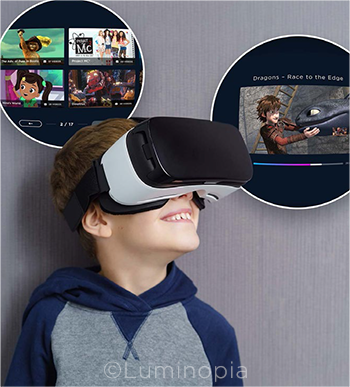Download PDF
How can ophthalmologists transform amblyopia therapy into something that children enthusiastically embrace? The answer might lie in replacing patches and eyedrops with videos and TV shows displayed with a dichoptic program on a virtual reality (VR) headset, results of a phase 3 multicenter clinical trial suggest.1
 |
VIDEO TX. The software used in the system modifies content in real time to encourage binocular fusion.
|
Gains in vision. Researchers randomized 4- to 7-year-old children to one of two groups. While all children continued with their vision correction, those in the treatment group (n = 45) viewed dichoptic videos for one hour a day, six days a week, while those in the comparison group (n = 45) wore a placebo headset.
At the end of 12 weeks, the children in the video group had gained a mean of 1.8 lines (95% confidence interval [CI]: 1.4-2.3 lines) of visual acuity in the amblyopic eye. In contrast, those in the control group gained a mean of .8 lines (95% CI: 0.4-1.3 lines). The 1-line difference between groups was statistically significant (p = .0011).
Study surprises. “We weren’t really expecting to see results so quickly, but within four weeks we were already seeing statistically significant improvements [in those who watched videos], compared to wearing eyeglasses, and that difference persisted over the full 12 weeks of the trial,” said David G. Hunter, MD, PhD, at Harvard Medical School and Boston Children’s Hospital. Moreover, he said, “Adherence to prescribed therapy was 86%, far beyond what we can achieve with patching.”
How it works. The video system, Luminopia One (Luminopia), consists of an off-the-shelf VR headset (currently the Samsung Gear VR) plus a smartphone and associated app for choosing the video that will be streamed.
To keep children engaged, the system allows them to choose from a cloud-based library of 546 hours of popular commercial programs. (Parents have an online portal to monitor their child’s progress and viewing choices.)
The system’s treatment algorithm blurs different sections of the images seen by each eye, Dr. Hunter said. “It blurs complementary parts in the amblyopic eye and the better eye, so this requires the brain to put the puzzle pieces together in order to see the full picture,” he said.
What’s next? Further research will be needed to determine how long gains in vision persist and how well the video system works with older children, Dr. Hunter said. In addition, outcomes achieved with the system need to be directly compared with those achieved with patching and atropine therapy.
On Oct. 20, the FDA granted de novo premarket approval of Luminopia One. The company plans to launch it in the second quarter of 2022. For now, the results are exciting for clinicians who are concerned about noncompliance with the existing therapies, Dr. Hunter said. “It’s great to be able to imagine a day when we can tell parents that we can treat their child’s amblyopia by having them watch TV for an hour a day through this device.”
—Linda Roach
___________________________
1 Xiao S et al. Ophthalmology. Published online Sept. 14, 2021.
___________________________
Relevant financial disclosures: Dr. Hunter—Luminopia: C,O.
For full disclosures and the disclosure key, see below.
Full Financial Disclosures
Dr. Ambati iVeena: O; NEI: S; Research to Prevent Blindness: S.
Dr. Bursztyn None.
Dr. Hunter Lippincott Williams & Wilkins: P; Luminopia: C,O; Rebion: C,O,P; Slack: P.
Dr. Shen American Glaucoma Society: S; Topcon: S.
Disclosure Category
|
Code
|
Description
|
| Consultant/Advisor |
C |
Consultant fee, paid advisory boards, or fees for attending a meeting. |
| Employee |
E |
Employed by a commercial company. |
| Speakers bureau |
L |
Lecture fees or honoraria, travel fees or reimbursements when speaking at the invitation of a commercial company. |
| Equity owner |
O |
Equity ownership/stock options in publicly or privately traded firms, excluding mutual funds. |
| Patents/Royalty |
P |
Patents and/or royalties for intellectual property. |
| Grant support |
S |
Grant support or other financial support to the investigator from all sources, including research support from government agencies (e.g., NIH), foundations, device manufacturers, and/or pharmaceutical companies. |
|
More from this month’s News in Review